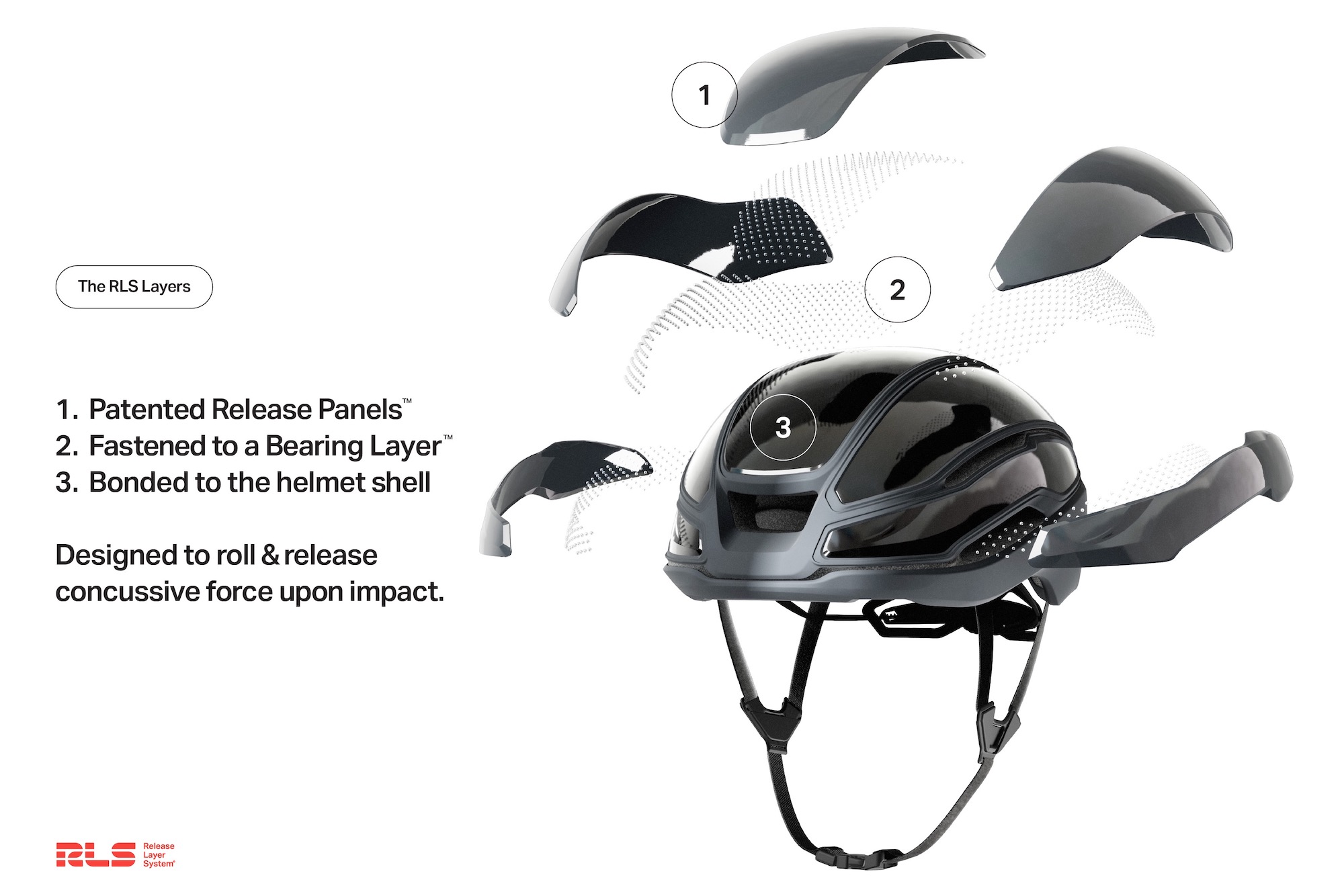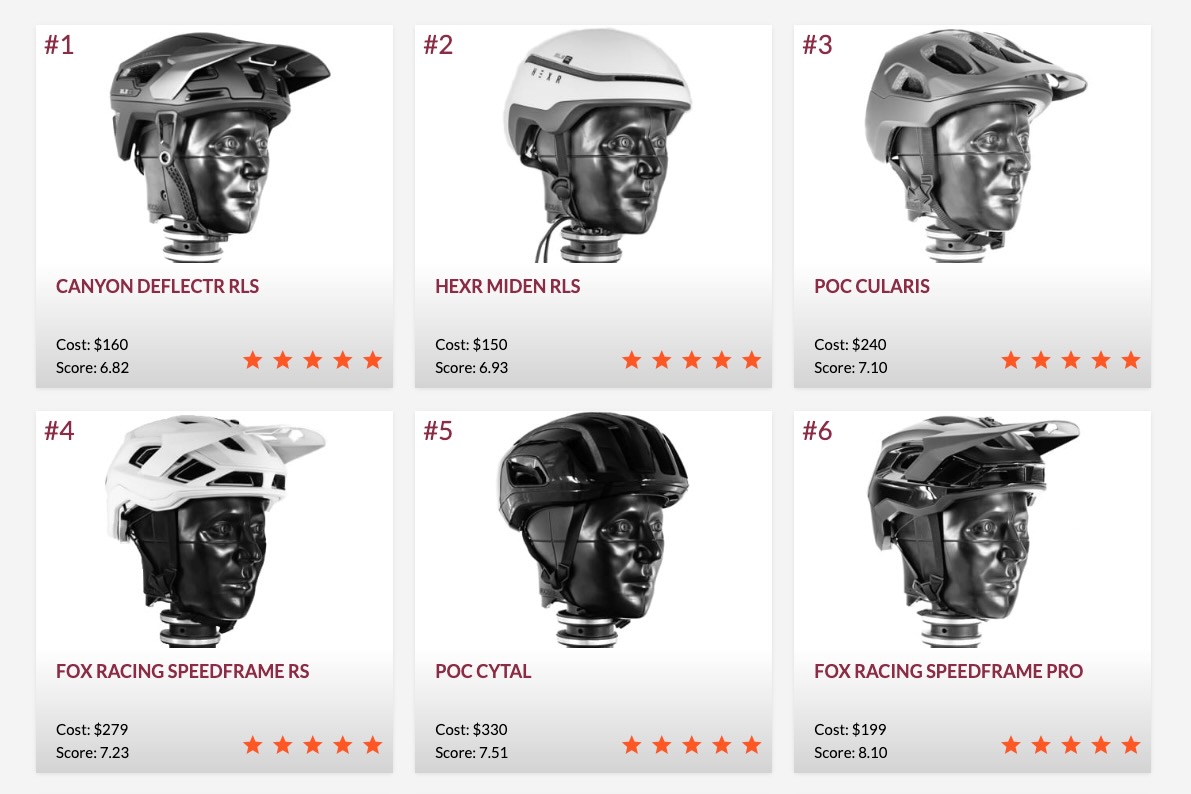RLS is an acronym for Release Layer System, and is a brand-new helmet safety technology being introduced today. Like MIPS and other similar systems, RLS aims to reduce the forces of rotational impacts transmitted to the brain with the goal of reducing the likelihood and/or severity of concussions and brain injuries. Unlike MIPS systems, however, RLS takes a different approach with a novel design that involves panels on the exterior of the helmet connected to a polycarbonate bearing layer that is intended to roll and release on impact.
The first model to incorporate RLS in its design is the Canyon Deflectr RLS trail helmet. While it hasn’t even officially launched yet, the Deflectr helmet just took over the top spot in Virginia Tech’s Bicycle Helmet Ratings with the lowest (best/safest) score of the 281 models tested. Interestingly, the #2 rated helmet on the list is the new HEXR Miden RLS, which also features this new safety tech.
With recent updates to the Virginia Tech Star-Rating System and increasing competition among helmet brands, helmets are getting safer and it’s becoming much harder to top the rankings. So, launching a brand new rotational impact protection system with the two new top-ranked helmets in Virginia Tech’s independent helmet testing is a very strong endorsement of its effectiveness. Let’s dive into the details of RLS’s unique design to see how it works.
What is RLS?

RLS is a patented technology and a completely new approach to rotational impact protection. It consists of a number of external shell panels that are connected to the helmet with a layer of small polycarbonate bearings. When impacted with enough force, this “technology is designed to work in a matter of milliseconds. The bearings are free to roll in any direction to allow the RLS panel to release, thereby redirecting concussive forces away from the brain.”
It’s a three-stage process which the company describes as:
- React: The patented RLS adhesive layer is engineered to react instantaneously to specific impact force, releasing its grip and allowing bearings to roll.
- Roll: The RLS Panel is now free to roll on lightweight polycarbonate bearings in any direction, to redirect rotational energy from the brain.
- Release: The RLS Panel releases to further dissipate rotational energy, which can help better protect helmet wearers from concussive force.
Apparently, the idea for the RLS system “was discovered almost by accident, by the founder of RLS, Jamie Cook.” Cook is also the co-founder of the 3D-printed helmet company HEXR. At one point, he “noticed that the outer shells of his colleague’s 3D printed helmet released in an accident, and this action was found to significantly reduce rotational forces and the risk of concussion.” Based on this observation, Cook and his research team began to explore ways of replicating this releasing reaction, and ultimately came up with RLS.
How Well Does RLS Work?

The latest Virginia Tech helmet ratings list the RLS-equipped Canyon Deflectr RLS and the HEXR Miden RLS as #1 and #2 in the rankings, respectively. The Canyon Deflectr is a new, yet-to-be-released mountain bike half-shell. It earned the #1, safest helmet ranking with a low score of 6.82, beating out the Poc Cularis (7.10) and the Fox Speedframe RS (7.23). Details on this new helmet are sparse, but it appears to be a modern half-shell helmet that uses Canyon’s unique but polarizing HighBar chinstrap design. It has a retail price of $160, which is significantly less than any of the other mountain bike helmets in Virginia Tech’s top ten.
Additionally, the HEXR Miden RLS landed in the #2 spot with a low score of 6.93. As mentioned above, HEXR was co-founded by RLS’s founder, Jamie Cook. The brand’s website was just updated, and it includes two models of helmets, one of which is the urban-oriented Miden RLS. This helmet has a decidedly commuter-esque design, retails for $150, and should be available sometime in October. The HEXR website also includes an “aero road helmet” with RLS called the Sifer. It should be available in the spring of 2026 and will cost $250.

Per the press materials provided to us by RLS: “Tests conducted by ICUBE at the University of Strasbourg — a world-leading research centre in biomechanics — found that helmets with the Release Layer System reduced Peak Rotational Velocity by an average of 56% – 66% across different impact locations, compared to the same helmets without RLS. This corresponds to a 68% – 84% reduction in the probability of brain injury as estimated by the Abbreviated Injury Scale – Level 2.” Based on both Virginia Tech’s helmet ratings and test results like those mentioned here, it certainly seems like this new technology functions as intended.
We Have One Question

We’re all for enhancing rider safety through new designs and technologies, but RLS leaves us with one burning question. What happens to all the polycarbonate ball bearings after a panel or panels have been released in an impact? In the impact test video shared with us by RLS, it appears that both the shell panels and the ball bearings (or at least some of them) release from the helmet. The panels look to be large enough that they’ll be easy to find and pick up, but the ball bearings are quite small and likely to be lost forever on the ground. If that’s the case, it seems like a small amount of plastic waste is a tradeoff for this helmet safety technology — assuming you ever hit your head with enough force to activate the RLS panels, that is.
When Will RLS-Equipped Helmets Be Available?

Canyon is the first brand to partner with RLS and include this technology in its helmet designs. The Canyon Deflectr RLS helmet broke cover today as part of the RLS announcement, primarily to demonstrate its effectiveness with its #1 Virginia Tech ranking. While we are aware of this new helmet, it isn’t available quite yet. According to RLS, the Deflectr helmet is “due for release later this autumn.”
The RLS-equipped HEXR Miden RLS is also expected to be available sometime in October. Beyond that, we’re told that “over the coming months, RLS will announce further leading brands and partners that will incorporate RLS technology.”
For more information, check out the RLS website.
